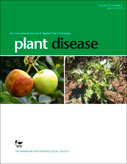Cereal cyst nematodes (CCNs) are an important group of sedentary plant-parasitic nematodes that restrict production of cereal crops throughout the world (Smiley et al. 2017). Heterodera filipjevi is considered one of the most destructive Heterodera species and causes significant damage in global wheat production (Dababat et al. 2015). In April 2016, two populations of cyst nematode were collected from Lamtar (35°4′4″ N; 0°47′53″ W) and Telagh (34°47′6″ N; 0°34′23″ W) wheat (Triticum durum) fields of Sidi Bel Abbes province in Algeria. The wheat fields had stunted patches, poor plant growth, chlorotic lower leaves, and few or no tillers. Cyst extraction from soils taken from the Lamtar and Telagh fields resulted in 9 and 11 cysts per 100 cm3 of soil, respectively. The cysts were extracted from soil using a Fenwick can technique (Fenwick 1940) and identified by morphology and morphometric analysis as well as by internal transcribed spacer (ITS)-rDNA sequencing. Morphologically, the cysts were lemon shaped with a posterior protuberance. The vulval cone was bifenestrate with horseshoe-shaped semifenestra and had strongly developed bullae and an underbridge. Measurements (range, mean ± SD) of cysts (n = 12) were as follows: body length including neck (670 to 871 µm, 782.6 ± 47.0 µm); body width (360 to 510 µm, 455 ± 42 µm); neck length (75 to 129 µm, 99.2 ± 18.6 µm); fenestra length (40 to 59 µm, 48.4 ± 8.5 µm); fenestra width (22 to 28 µm, 25 ± 2.4 µm); underbridge (78 to 88 µm, 83 ± 5 µm); and vulval slit (6 to 10 µm, 7.7 ± 1.6 µm). Measurements of J2 (n = 15) were as follows: body length (458 to 588 µm, 524 ± 26 µm); stylet (23 to 26 µm, 24.3 ± 0.8 µm) with anchor-shaped basal knobs; tail (46 to 61 µm, 57.7 ± 3.1 µm); and hyaline tail terminal (29 to 40 µm, 33.5 ± 2.1 µm). The values of the morphological and morphometrical characters of both populations were within the range of those from H. filipjevi (Subbotin et al. 2003). Molecular observations were performed, and DNA was extracted from two juveniles from two different cysts separately (Holterman et al. 2006). Ribosomal DNA from the ITS was PCR amplified from a single cyst from each population using primers TW81 (5′-GTTTCCGTAGGTGAACCTGC-3′) and AB28 (5′-ATATGCTTAAGTTCAGCGGGT-3′) (Subbotin et al. 2003), respectively, and sequenced. Two of the nucleotide sequences of ITS (accession nos. KX574302 and KX574299) regions were submitted to GenBank. To verify the identity of the sequences, sequenced products were subjected to a database search using BLAST. This comparison revealed a sequence similarity of 98 to 99% with H. filipjevi. Therefore, the morphological and molecular data revealed the existence of H. filipjevi in Algeria. Reproduction of H. filipjevi on the durum wheat (cultivar Capa) was confirmed by inoculating 500 viable eggs onto 5-week-old wheat seedlings grown in pots (10-cm height and 7-cm diameter) filled with sterilized sand at 22°C. Pots of noninoculated seedlings served as controls. Sixty-three days after inoculation, an average of (46 cysts, n = 3) were extracted from both soil and root, demonstrating multiplication on this host. No cyst was found on the control plants. To our knowledge, this detection represents the first report of H. filipjevi in Algeria. Because wheat has an important socioeconomic value for Algeria, additional surveys are needed in other wheat-growing areas, and control measures should be taken to stop the multiplication of this species. The use of resistant wheat varieties and proper crop rotation is recommended.

